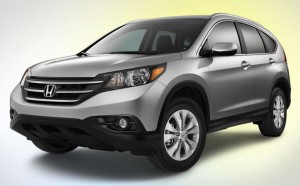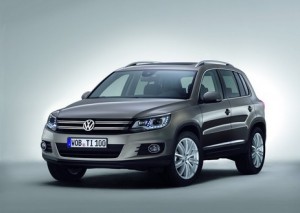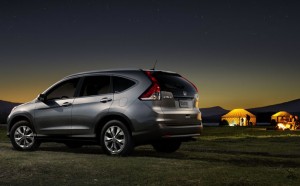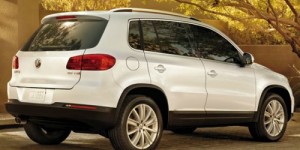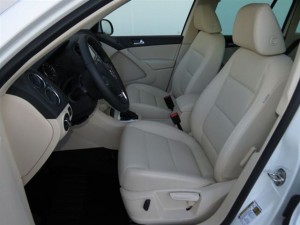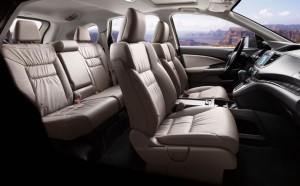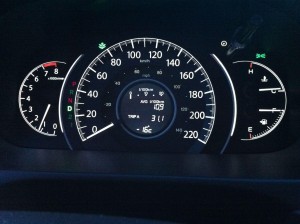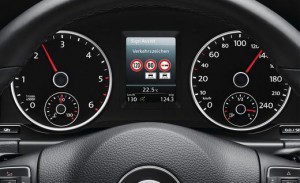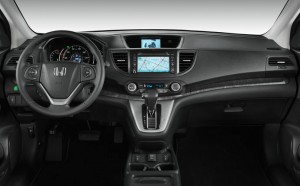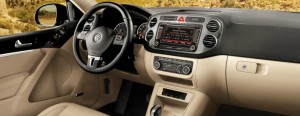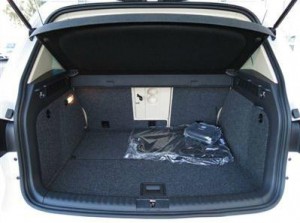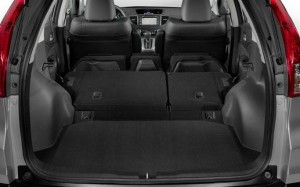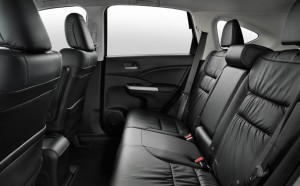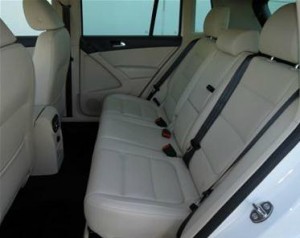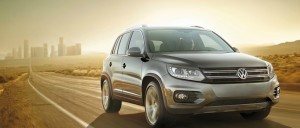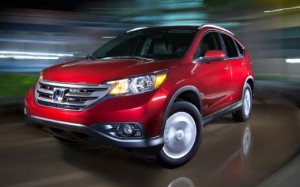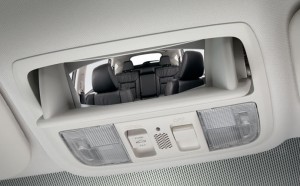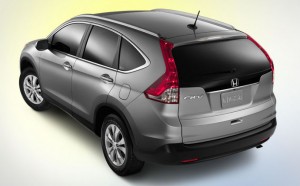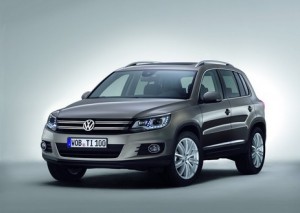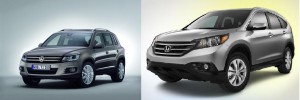Looking for a review on the 2013 Honda CR-V? I’ve posted one here.
You read that right – a comparison test.
I will be doing Wildsau Comparos on occasion, if I find a couple of vehicles I review are direct competitors and if I have the opportunity to review them together.
It’s the way I’d shop for a car, and if I can give you the goods on both at the same time…. why not?
The category here is the ever-popular crossover. Basically what we might have referred to as small sport-utes in the past, but based on car platforms, and much more suitable for what 99% of the drivers need them for. Without further ado, let’s delve into today’s Battle Royale, shall we?
2012 VW Tiguan 4-Motion
Pricing
Today’s warriors are Honda’s CR-V and VW’s Tiguan. The CR-V came in the Touring trim level, which is essentially loaded and rang in at CDN $36,580 including freight and destination. The Tiguan was the Comfortline, which sounds more like a toilet seat than a trim level and sits kind of in the middle of the line-up. It listed at CDN $37,130 all-in – very close to the CR-V. The issue is that there’s still a higher trim line for the Tiguan, and it starts at over $38,000. Hey-oooooh! Not only that, but load up the top-line Tiggy, and you’ll be sitting at just a few grand less than its big brother, the Touareg. No need to buy a vowel with that name. The CR-V Touring gives the buyer numerous upgrades at the already-lower price.
Advantage: CR-V
Under The Hood
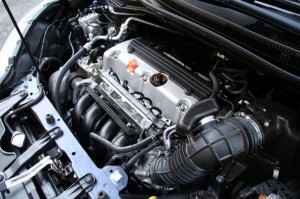 So, what’s going on under those hoods? The CR-V brings what seems like an antiquated engine to the game. It’s a 2.4-Litre, inline-4. Naturally aspirated. Nothing really special going on. It puts out 185 HP @ 7000 RPM and 163 lb.ft of torque @ 4400 RPM. It lumps this together with another seemingly old-tech 5-speed automatic transmission – no sport mode, no manual shifting. Chuckle all you want though – the CR-V puts up some great fuel economy numbers, rating at 9.2 L/100 km (25.8 mpg) in the city, 6.6 L/100 km (35.6 mpg) on the highway and 8.1 L/100 km (29 mpg) over the combined cycle. I saw around 11.5 L/100 km in almost purely city driving, with no attempt at being economical. The tank is 58 Litres – and should be bigger.
So, what’s going on under those hoods? The CR-V brings what seems like an antiquated engine to the game. It’s a 2.4-Litre, inline-4. Naturally aspirated. Nothing really special going on. It puts out 185 HP @ 7000 RPM and 163 lb.ft of torque @ 4400 RPM. It lumps this together with another seemingly old-tech 5-speed automatic transmission – no sport mode, no manual shifting. Chuckle all you want though – the CR-V puts up some great fuel economy numbers, rating at 9.2 L/100 km (25.8 mpg) in the city, 6.6 L/100 km (35.6 mpg) on the highway and 8.1 L/100 km (29 mpg) over the combined cycle. I saw around 11.5 L/100 km in almost purely city driving, with no attempt at being economical. The tank is 58 Litres – and should be bigger.
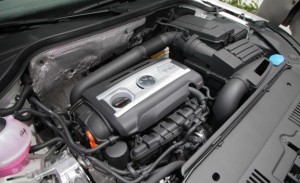 The Tiguan gets VW/Audi’s awesome 2.0-Litre, inline-4 – it’s turbocharged, intercooled and drinks its fuel through direct injection. The numbers are familiar by now, since we’ve seen this engine in plenty of other applications – 200 HP@ 5100 RPM and 207 lb.ft of torque at a deliciously low 1700 RPM. Unfortunately, these higher numbers don’t come free – mileage is significantly lower than the CR-V. The Tiguan is rated at 11.2 L/100 km (21 mpg) in the city and 7.7 L/100 km (30.5 mpg) on the highway. During almost all city driving, with a short sprint down the highway, I saw 12 L/100 km (20 mpg). The power is routed through a 6-speed automatic, with Sport mode and manual shifting option. The fuel tank is 63.5 Litres – also smaller than I’d like.
The Tiguan gets VW/Audi’s awesome 2.0-Litre, inline-4 – it’s turbocharged, intercooled and drinks its fuel through direct injection. The numbers are familiar by now, since we’ve seen this engine in plenty of other applications – 200 HP@ 5100 RPM and 207 lb.ft of torque at a deliciously low 1700 RPM. Unfortunately, these higher numbers don’t come free – mileage is significantly lower than the CR-V. The Tiguan is rated at 11.2 L/100 km (21 mpg) in the city and 7.7 L/100 km (30.5 mpg) on the highway. During almost all city driving, with a short sprint down the highway, I saw 12 L/100 km (20 mpg). The power is routed through a 6-speed automatic, with Sport mode and manual shifting option. The fuel tank is 63.5 Litres – also smaller than I’d like.
Advantage: Tie – the Tiguan has better and more accessible power, but gives up quite a bit of ground in terms of fuel economy to the CR-V – I guess it depends on what matters more to you as the buyer in this case
Exterior
The CR-V is an all-new offering for this model year, and Honda has done a great job at letting the CR-V grow up. The styling is bigger, yet the vehicle isn’t. It has the same wheelbase and basic dimensions, and it is essentially an evolutionary model with a very similar silhouette, yet it comes across more mature and bigger than it was, and certainly has some interesting changes. Up front you’ll find Honda’s new corporate face, which is handsome, if not boring, and there are subtle but effective changes at the back as well. The biggest change in terms of looking at the 2012 CR-V was the angle of the rear pillar – it’s a nice style element and it actually helps with rearward visibility. The Touring has nice 17″ rims, fog lights and roof rails. All in all, the CR-V looks like it wants to stretch toward a higher-than-entry-level class, and it’s a good-looking ride.
The Tiguan is an evolution from the last generation as well, and as with the CR-V, an improvement. It has nice smooth lines, and retains the slightly stubby look, with a short rear overhang. The Tiguan also sports the corporate face that VW is plastering all over their line-up. At first, I was quite unhappy with it. Wherever I’d see it, I felt as though VW has taken a step into the blah, and is bowing to the pressure of making their vehicles look like everything else out there. But it has grown on me, and I thought it looked quite handsome on the Tiguan. Interestingly, a number of people commented that the front-end of the Tiguan looked mean and aggressive – not what I got out of it, but hey… The Tiguan is quite a small vehicle, and surprised me a number of times when parked in my garage – at how little room it takes up. The rear end is nice and clean, and has VW’s new light clusters. Up top you’ll find roof rails and a sharkfin antenna. I appreciate that VW made the effort to put two chrome exhaust tips out back – I know it’s just appearance, but I like it.
Advantage: Tiguan gets the win here, but it was close for me
Interior
I’ve got to start with this. The materials. Driving these two vehicles back to back makes it easy to contrast certain things, and one that stood out immediately to me was the quality of the materials. The Tiguan has absolutely first-rate materials, and the entire dash is clad with gorgeous, rich-feeling soft-touch material. It feels expensive, it looks great and the textures and fit and finish are such that you feel that you’re driving something pricey. (OK, you are) I thought the interior was very well put together and I appreciated that VW styled it somewhat differently and made it an interesting place to be. I particularly liked the two-tone scheme – dark up high and light (tan) on the lower part of the interior. It felt airy and refreshing, especially in contrast to the full-on depressing black interiors VW crafts so well, and even gave the impression of more space. A shot of the Tiguan’s interior is below.
The CR-V also has a very nice interior, and it certainly feels more refined than previous generations. With that said, it’s still not upscale-feeling, and you’re surrounded by hard plastics everywhere, except for a little padding on the door panels. I do give Honda credit for sculpting some nice shapes, textures and color contrasts in there, along with an eye-catching grey faux-wood grain swath across the dash. The CR-V’s interior below.
Steering wheels – both vehicles have excellent wheels to work with. I liked the size and thick rim in the CR-V with controls for media, handsfree/phone and cruise control, and I loved the Tiguan’s firm wheel with flattened surfaces, and controls for media, driver information screen and the phone. Both are manually adjustable for height and reach.
Seats in both vehicles are very comfortable. The Tiguan is upholstered in perforated leatherette (it’s vinyl, people) – they look good, and feel good. I was impressed by the side bolstering, and disappointed with the thigh bolstering. Both front seats are manually adjustable and heated, with one strange exception – the driver’s side tilt function is powered.
The CR-V has real leather, although it honestly doesn’t look as good as the Tiguan’s leatherette. As noted, they’re comfortable, but need significantly more bolstering for any kind of fun driving. The driver’s seat is fully powered, and the passenger’s seat is manually adjustable. Both are heated, and have flip-down built-in armrests, which I liked very much!
In terms of space, you’ll find good headroom and legroom in both vehicles, even with the sunroof. The CR-V’s sunroof is a pretty typical one – decent, with power tilt and slide functions. The Tiguan’s sunroof is a different affair – it’s a full length panoramic deal – the front half of it tilts and slides, but having an almost full-glass roof serves to brighten up the interior significantly and makes things feel airy, especially in the back. There is also a full-length power-retractable sunshade.
In terms of layout, the CR-V has a bin of gauges, with the focus on a visual stack of circles in the middle – the speedo with a round driver information screen in the middle. The center stack gives you an additional upper information screen, a bigger touch-screen below that, then a dual-zone automatic climate control system, and a pod sticking out of the stack which houses the shift lever. The center console houses seat heater buttons, a 12V outlet and storage. LOTS of it, which I’ll talk about in a bit. Kudos to Honda for moving the shift lever up, and creating incredible versatile storage space. CR-V gauges below.
The Tiguan has a more standard gauge bin, with tach and speedo, and a driver information screen in the middle. The center stack starts with a touch-screen media system, an old-school manual climate control system, storage in various configurations, and a nice brushed-metal shift lever housing in the console. The VW’s gauge cluster below.
Advantage: Tie – I felt more focused in the Tiguan, and loved the materials, but I truly enjoyed the styling and the amenities in the CR-V
Tech/Convenience
The CR-V’s driver information screen is way too small, and way too busy in its circular form. It always shows instant fuel economy and outside temperature, and lets you access 2 trip meters, oil life, average mileage, odometer and fuel range. There are two “brackets” of light surrounding the speedometer – they change from white to green when you’re driving economically – whether you care or not.
There’s that upper screen, which I was introduced to in my time with the Civic, and it can display average fuel consumption and fuel range, a compass and a clock, media – what’s playing, wallpaper (any picture you want to upload) or can just be turned off. The touchscreen below it is bigger, and serves a lot of functions – it controls media, navigation, the phone and is the monitor for the back-up camera. Unfortunately, the user interface and the graphics were designed by people who hate people. It looks like crap, with crunchy graphics, and the user experience borders on painful at times – I give it low marks for friendliness. A neat touch, however, is that the back-up camera offers you three different views, and I liked that.
The media system feeds from AM, FM, satellite, auxiliary, CD, USB and Bluetooth streaming sources, and all of them worked well. The auxiliary and USB plugs are in the console bin, along with a 12V plug, and you’ll find another on the center console. The system plays through 7 speakers, which includes a subwoofer, but I felt that it didn’t sound good at all, from any of the sources.
Of course, you’ve got power windows, door locks and mirrors – all on the driver’s door.
On to the Tiguan, where tech offerings are slightly more sparse. The driver information screen is nice and sharp, and spacious enough to be easily read. It can display instant and average fuel economy, trip meter, outside temperature, odometer, travel time, fuel range, average speed, a digital speedo, vehicle settings, or media and phone information. It’s a dizzying array of options, and you almost wish you’d be able to see more than one at a time. The picture below is of the top-of-the-line interior, but essentially reflects what you’d see in other trim levels.
The touch-screen media system plays AM, FM, satellite, auxiliary, CD, Bluetooth streaming and MDI sources. MDI (Media Device Interface) is part of the $674 connectivity package option, and allows for iPod control. Aux and MDI connections, as well as a 12V plug, are in the center console bin. It’s a simple system, with hard buttons on the sides and a touch-screen to complement it. For the most part, the user interface works well and it’s effective, allowing you to control your media, as well as your phone functions. The 6-speaker system sounded great!
Power mirrors, door locks and windows are all on the driver’s door, and you’ll find an electronic parking brake on the center console.
That’s it. No navigation, no back-up camera, no extra screen at the top.
Advantage: CR-V, but by a smaller margin than I originally thought. I liked the back-up camera, and the layout of the goodies, but I really appreciated the simplicity in the Tiguan, and how well everything worked.
Storage
The Tiguan’s trunk is at the perfect loading height but the cargo space is smaller than I anticipated. You’ve got 23.8 cubic feet to work with, and 56.1 when the rear seats are folded down. There are 6 tie-down hooks, two of which ingeniously convert to bag hooks, and a hard tonneau cover that swings up with the trunk lid. The rear seats flip 60/40, using a pull strap on the side of the seats. You’ve certainly got enough room back there for a weekend trip, but might find a true road trip a bit more taxing and you’d probably need to get creative. A shot of the VW’s cargo space is below.
The CR-V’s trunk space on the other hand feels cavernous. It was much bigger than I thought it would be, and you have a hefty 37.2 cubic feet back there, which amps up to 61.4 with the seats folded. Nice. The lift-over height, and load floor, are both quite low – Honda boasts the lowest in the industry – making the space easily accessible and highly usable – even for….. little people. You’ve also got some tie-down hooks, some bag hooks and a little mesh pocket on the side, as well as a removable, retractable soft tonneau cover. Here’s where it gets interesting. Honda has placed a small lever on either side of the trunk – give either a quick yank, and the corresponding rear seat (split into 60/40) will quickly fold, using a brilliant combination of physics, and mechanics. No electronics to die, and it’s faster than those systems anyway. This set-up should be a lesson to ALL manufacturers. I absolutely loved it, and so did everyone I showed it to. And it’s very useful. The CR-V’s trunk with the seats down is shown below.
The Tiguan’s got some interesting other storage offerings. There are long, sculpted bins in the doors with integrated water bottle holders, and an array of storage areas in the center stack/console. An open cubbyhole, a shallow lidded slot with a 12V plug, a large open angled bin, 2 inline cupholders (with a retractable sliding lid), and a small bin under the armrest. It’s split into two halves, neither of which leaves you with much space. There’s a nifty, flip-put bin under the left side of the dash, by your left knee, which includes change holders. The glove compartment is average. As neat as all this storage is, and as well done as it appears (all the bottoms are rubberized, etc), you’re not left with a lot of good, usable, flexible storage.
Enter the CR-V. Again, there are a bunch of little storage options – small door bins, a neat little tray in the door panel underneath the grab handle, a small bin under the left side of the dash, two long shallow bins on either side of the center console in the footwells, and a mediocre glovebox. Here’s the kicker. Moving the shift lever onto the center stack allows for a very roomy console, and Honda hasn’t wasted it. They decided to make the whole thing, short of a couple of cupholders, a single, massive storage compartment with a retractable, scrolling lid. It’s about 16″ long and about 8″ wide, and very deep. To call it useful and flexible is an understatement, considering it’s big enough to smuggle a few koalas in there. Not that you’d ever do that.
Advantage: CR-V
Rear Seats
The CR-V’s doors open very wide, making for very easy ingress, and also loading or taking out kids. The seats are nicely upholstered and very comfortable, and the legroom and knee room are exceptionally good – almost shocking. Headroom was pretty good as well.
You’ve got 3 seats, with 3 headrests and 3 seat belts back there. I’d consider it great for 2 adults, manageable for 3 if you’re looking at short distances – this is aided by an almost flat floor. With that said, we transported our 3 kids, including a full child seat and a butt-booster and they were very comfortable back there. Width-wise, it’s surprisingly roomy. There are 2 sets of LATCH anchors.
There are 2 seatback map pockets, small but usable door bins, a ceiling-mounted reading light and the middle seatback folds down to become a fantastic armrest with 2 integrated cupholders. That’s it. No plugs, no vents, no nothing.
The Tiguan’s rear seats are also a very comfortable place to be. Seats are as nicely upholstered as the front, and as with almost any other vehicle, are almost completely devoid of any bolstering. Interestingly, the rear seats are adjustable – they slide forward and back, and can be reclined, using the pull-strap that folds them flat. That flexibility is uncommon for rear seats, especially in smaller vehicles.
Again, you’ll find three seats, 3 headrests and 3 seat belts, and again fitting 2 adults is no issue. That middle seat, however, is more cramped and any adult forced to ride there will likely be punching you in the neck in short order. It was cramped for our 3 kids, and they had to dig deep to find seatbelt receptacles. 2 LATCH anchors are there for kids’ seats. Legroom was surprisingly generous, as was the headroom. As noted earlier, the full length sunroof really opens up the rear seats and makes it feel nice and airy back there.
There are tall door pockets, and 2 seatback pockets, as well as reading lights on each side.
The slightly smaller feeling rear seats in the Tiguan are compensated for with amenities not found in the CR-V – the Tiguan’s passengers get adjustable air vents back there, an additional 12V plug and a little storage cubby at the back of the console. The middle seatback also folds down to make an armrest with cupholders in it.
Interestingly, I found power window AND door switches on either side in the back – I’m not sure if I’ve ever seen that before.
Neither of these little crossovers’ rear seats would be a bad place to be in for a road trip.
Advantage: Tiguan, by a small margin – although it’s slightly less roomy width-wise, the seats are adjustable and there are more luxurious appointments for the rear passengers
The Drive
I understand that these are crossovers, and so you can’t expect truly car-like behavior from them – or can you? I am starting to think that you can, and I’ll tell you why.
The Tiguan was truly a fun vehicle to drive. First of all, it drives well. Its engine, after a moment of lag, pulls hard through mid-range RPMs, snarls all the way when you’re on the gas, and whilst you’re playing, you have a fat, juicy torque curve that lets you do things you just can’t in other vehicles. Like the CR-V.
The VW’s 6-speed is not a particularly new transmission, and although it is a smooth one, it likes to head for the higher gears, and it shifts quite luxuriously (read: slow). Put it in Sport mode, and it will sharpen up the throttle response, as well as hold shift points well beyond 3000 RPM. It’s still not as sporty as their DSG transmission, but perhaps it’s more suitable for this vehicle.
The handling is excellent, and it attacks corners with very little body roll, and more eagerness than you might expect. I enjoyed the steering feel, and feedback. The ride is good – firm, but well-isolated, and I found little or no harshness to complain about.
The Tiguan is also very comfortable at cruising and highway speeds, as well as getting there effortlessly. I often looked down to find myself driving 20-30 km/h faster than I thought I was. The vehicle is very quiet in terms of wind, road and driveline noise, and felt exceptionally stable at highway speeds.
The all-wheel drive system was highly effective – transparent in dry conditions, and great in the snow, with a little sporting push around corners. Low-speed maneuvering was good, with a nice, tight turning radius.
For an all-wheel drive crossover, this thing was a blast and it actually felt quick! Kudos to VW for trying to make something this versatile a driver’s vehicle.
The CR-V’s drive is not nearly as fun. Don’t get me wrong. It’s a good driving experience, just completely different and mostly bland. Make that blah-nd. The low-end grunt of this engine is actually quite satisfying, and though it’s not a quick vehicle, it’s fine for everyday driving. The engine revs smoothly, and gets a bit noisy under load. I wasn’t too fond of the 4-cylinder’s sound at higher RPMs – it got more honky than snarly for me.
The transmission, although down in gear ratios, is smooth and very intelligent. I never found myself wanting for more cogs, and thought it did a great job.
The CR-V was very quiet in terms of wind and road noise, which is a major improvement over the last generation. Low-speed turns and parking was excellent and a breeze, thanks to the electronic steering. Unfortunately that same system is a complete turd on the road, where you’re left with virtually no feedback and no on-center feel. This is especially tragic, considering the great steering feel I’ve come to expect from Honda.
The suspension was a bit of a surprise to me. I found the ride was quite a bit harsher than I expected, and particularly rough over irregular surfaces like washboard roads. I also felt there was quite a bit of body roll into corners. With that said, the handling was fine and it felt competent around corners and in everyday driving.
Honda’s revised all-wheel drive system remains quiet and transparent, but now kicks in sooner – you no longer have to lose traction with the front wheels to engage the all-wheel drive. Its job is, of course, to maximize traction on crappy surfaces and it does a good job. I had this during Edmonton’s biggest snowfall this winter, and it pulled through everything admirably.
A final note – the CR-V offers Honda’s ECON mode. It’s a dash-mounted button, and I’m not sure what it does. It seems to retard the vehicle’s responses to save some fuel, and it wasn’t bad. It’s more sluggish, but not nearly as horrifying as in the Civic, where it felt almost undrivable.
The CR-V’s drive is perfectly adequate, but in this comparo, that’s not good enough.
Advantage: Tiguan
Details
The CR-V’s overhead sunglass holder has a 2nd position, leaving it partially open, and revealing a convex “conversation” mirror – we have the same thing in our Odyssey van, and it allows you to see EVERYone in the vehicle, which means you can finally see who really hit who in the back seat.
I liked the “expanded view” mirror that Honda added to the driver’s side view mirror – it makes the leftmost inch or so a convex mirror, allowing you to see significantly more than you could in a standard mirror.
The Tiguan has a fantastic dead pedal space – one of the best I’ve used.
It’s still built in Germany, unlike many German-engineered cars nowadays, and the doors close with that reassuring Teutonic thunk, instead of a metallic clunk. Tough to explain, but it feels good.
Nitpicks
I heard an irritating rattle/creak from the rear lift gate over irregular surfaces in the Tiguan. Interesting, but not shocking – every single VW and Audi product I’ve ever owned myself (4 of them) has developed that same issue. It’s adjustable and it goes away, and it comes back. Drives me crazy!
The Bluetooth control buttons are overhead – that’s not very helpful when you’re trying to drive with fewer distractions. There IS a rudimentary single phone button on the steering wheel too.
Strangely, the Tiguan’s stereo always turned on my Bluetooth streaming music from my phone, even when I clicked the button to tell it not to.
The lovely 2.0-Litre guzzles premium fuel and these days, that’s a big deal. It makes for a big difference at the pump.
I guess I was a bit taken aback that a back-up camera isn’t even an option as far as I could tell, and some features found on significantly cheaper vehicles aren’t found here either – HomeLink garage door opener, automatic headlights, etc.
The CR-V’s most brutal nitpick came from the constant disconnecting and reconnecting of my phone. It seemed to be related to the forward and stopping motion of the vehicle, and it honestly happened a minimum of a half-dozen times each time I drove it. To ensure the experience was the worst it could be, the reconnecting was announced by a lady EVERY SINGLE TIME – luckily for her it’s not proper to hit a lady, because I was ready to find her in the car and take her outside for a good pummeling.
I found the touch-screen was very susceptible to glare and the screen often turned itself off. I think there is probably a setting to stop that from happening, but I couldn’t be bothered to wade through the user interface to find it.
When stepping on the dead pedal in the CR-V, the parking brake pedal cut right into my shin. Awesome. Way to encourage use of the dead pedal.
For such a well though-out rear seat in the CR-V, it would have been nice to add at least a 12V plug, or better yet, a 110V house-hold plug.
Verdict
This was a tough one. Although comparable in size, price and amenities, these vehicles are significantly different in character, in design and how they go about their jobs.
I actually enjoyed using both of them, but I only enjoyed driving one of them. I was surprised at the utility and storage space in both of them, but was only impressed by one of them in this category. Both impressed me in terms of the rear seat space.
In the end, I don’t think I can choose a really clear, run-away winner here. I give the CR-V a 7.5 out of 10, wishing there was more joie de vivre to speak of. The Tiguan gets an 8 out of 10 from me, thanks to its ability on the road, but I wish it would offer more space and utility. Though I give the Tiguan a higher score here, the truth is that I’d probably end up giving the CR-V the nod for my family’s needs. Honda’s reliability, and significantly cheaper price for a similar level of equipment, would likely end up winning my dollars.
Either of these contenders is quite a fine vehicle, and will make any family of 1 to 4 people happy.
WAF (Wife Acceptance Factor) was excellent for the Tiguan (she loved the interior, the lit vanity mirror, the driving position and surprisingly, the “peppiness”) and very good for the CR-V (she loves that it’s a Honda, the height, the trunk space and the ability to load kids into it easily).
Disclosure: Vehicles were provided by VW and Honda.
If you enjoyed this review, feel free to check out my other vehicle reviews under the car reviews tab at the top of my blog.

